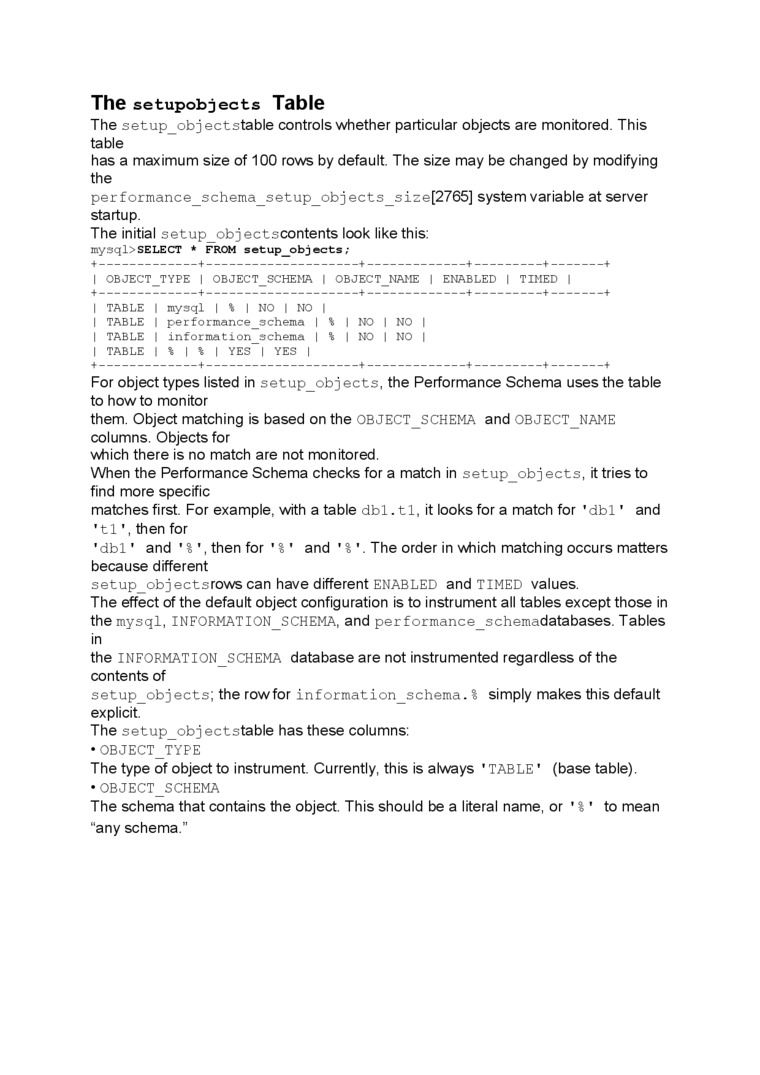89552

The setupobjects Table
The setup_objectstable Controls whether particular objects are monitored. This table
has a maximum size of 100 rows by default. The size may be changed by modifying the
performance_schema_setup_objects_size[2765] system variable at server startu p.
The initial setup_objectscontents look likethis:
mysql>SELECT * FROM setup_objects;
|
OBJECT |
------+--------------- _TYPE | OBJECT_SCHEMA |
-----+--- 1 OBJECT_ |
NAME 1 |
-----+----- 1 ENABLED | |
-----+-------- 1 TIMED | |
|
TABLE TABLE TABLE TABLE |
1 mysąl | % | NO | NO 1 performance_schema | I information schema | I % | % | YES | YES | ------+--------------- |
1 % 1 NO 1 % | NO | -----+--- |
1 NO | 1 NO | |
-----+----- |
-----+-------- |
For object types listed in setup_objects, the Performance Schema uses the table to how to monitor
them. Object matching is based on the OBJECT_SCHEMA and OBJECT_NAME columns. Objects for
which there is no match are not monitored.
When the Performance Schema checks for a match in setup_objects, ittriesto find morę specific
matches first. For example, with a table dbl. 11, it looks for a match for ’dbl' and *tl', then for
'dbl' and ' % ', then for ' % ' and ' % '. The order in which matching occurs matters because different
setup_objectsrows can have different ENABLED and TIMED values.
The effect of the default object configuration is to instrument all tables except those in
the mysąl, IN FORMAT ION_SCH EMA, and per formance_schemadatabases. Tables in
the IN FORMAT ION_SCH EMA database are not instrumented regardless of the contents of
setup_objects; therowfor information_schema. % simply makes this default explicit.
The setup_objectstable has these columns:
• OBJECT_TYPE
The type of object to instrument. Currently, this is ałways ' TABLE' (base table).
• OBJECT_SCHEMA
The schema that contains the object. This should be a literał name, or * % ' to mean "any schema."
Wyszukiwarka
Podobne podstrony:
The setupactors Tsble The setup_actors table contains information that determines whether to enable
Example Consumer Configurations The consumer settings in the setup_consumers table form a hierarchy
ex3 7 ń>F0 SO&TtASMj Make changes to originą] program (The caret, indicates a control
f30 1 LŹ template3 THE C0MPARE1 OBJECT Lowest: 15 Highest: 25 Equal: 0 THE COMPARE2 OBJECT
00189 A37141fa93300ce1faeaaf4f0e37185 190 McWilliams is maximized at r = 2, so the input parameters
Institute of Control and Industrial Electronics <& w n The history of the Institute of Contro
MR293R190?0 1 AHALYSIS Depending on the extent and location of a repair, you are requeated to asses3
096 jpeg Nome_______ SM: RceogrtBog Urg*s» Circłe and cołor the targest object In each
Table 1.1. The global recovery will remain moderate OECD are 1998-2007 2008 2009 ed
2 12 2 Three stages of negotiation Next Slide i !► * The main objective of the mid
Realisation of the social objectives of sustainable development is related to the education issues.
The principal objective of the environmental agriculture programmes is to promote Systems of agricul
V Assume that the test object can be represented by an n-degree-of-freedom lumped-parameter model(1)
15 UN DEBAT : LES MENTALTTES COLLECTIVES 605 the Governor of the Town to enąuire whether it wil
Bijsterveld, K. & Krebs, S. (2013). Listening to the Sounding Objects of the Past: The Case of t
4.1.2. The Yiew and the Controller XML-based technologies are intensively used in the presentation l
więcej podobnych podstron